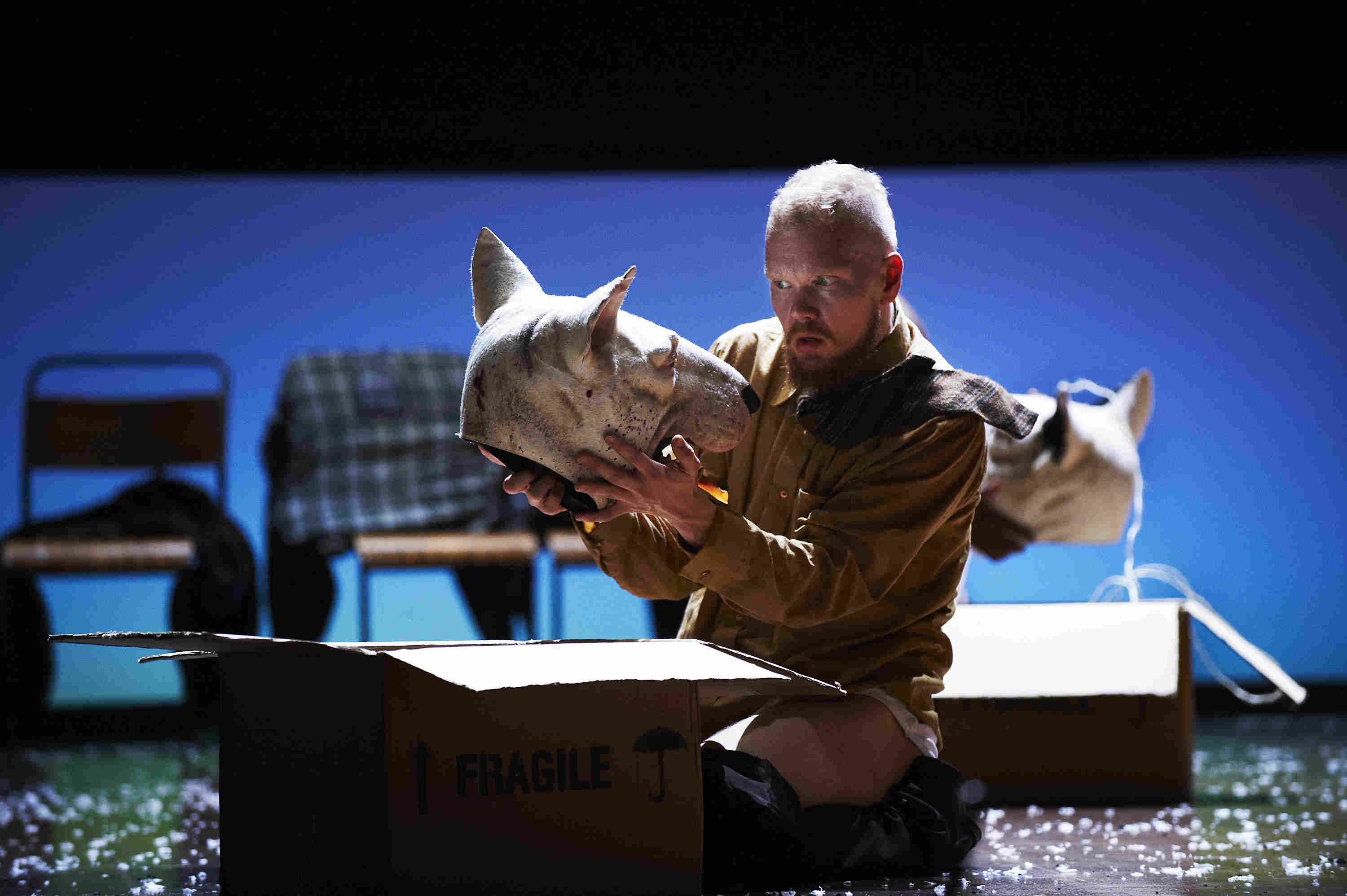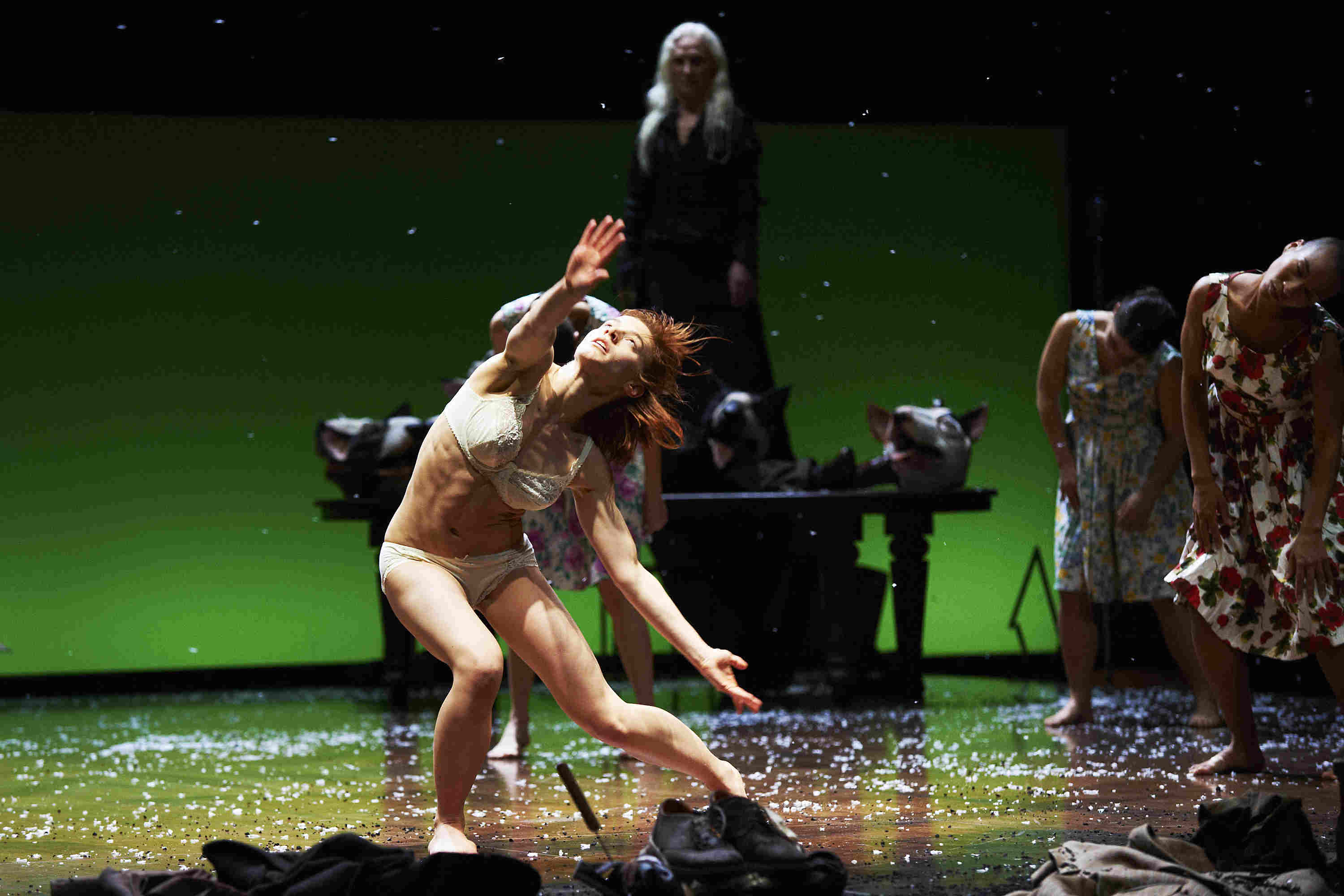The Rite of Spring & Petrushka, Fabulous Beast Dance Theatre, Sadler's Wells | reviews, news & interviews
The Rite of Spring & Petrushka, Fabulous Beast Dance Theatre, Sadler's Wells
The Rite of Spring & Petrushka, Fabulous Beast Dance Theatre, Sadler's Wells
Dance theatre at full throttle in two contemporary takes on Ballets Russes classics

Stravinsky’s Rite of Spring captures the pulsing terror of seasonal change, the relentless onward drive of nature that brings death closer even as life burns at its most ferocious. The 1913 première of the ballet created by Vaslav Nijinsky infamously caused a riot in its Parisian audience. Michael Keegan-Dolan’s version for his company Fabulous Beast has terrifying dog heads and men furiously humping the ground.
But oh, how happily wrong you would be! This double bill is just the thing for any mood and season - dance theatre at its fullest throttle, enthralling and rewarding, even better than drinks on pavements and cherry blossom (or at least worth deferring them for). Keegan-Dolan is a rarely gifted dancemaker and in this Stravinsky two-parter he gets so many things absolutely right that this critic left wreathed in smiles; if I could, I’d scrawl big red Biro ticks over it all, cheerful as a schoolteacher on the last day of term.
First, music: a live orchestra! Praise be. Even the inevitable Sadler’s Wells amplification was (from the front stalls at least) not irritating enough to detract from the pleasure of hearing the first notes, so like the first pale rays of an ancient morning, in the always-strange timbre of real oboes and real bassoons. After a slightly timid opening, David Brophy and the players of the Royal Ballet Sinfonia delivered a fine, crisp performance – no holding back on those drums in the Rite – and wrung some really delicious, unusual sweetness from Petrushka.
 Keegan-Dolan’s Rite captures a violent and sacrificial mood without following too linear a story. Indeed, that’s one of its beauties: violence erupts in unexpected directions, and those who seemed safe – the grave older man who sits apart – become its victims, while the Chosen One is attacked but seems not to die, finishing instead with arms uplifted – triumphant? Mob violence is mostly perpetrated by the group of hard-faced men, in flat caps and woollen trousers like some Great Depression dole queue, but – lest we get too comfortable with our notions of gender – women can join in. Cross-dressing also undermines gender binaries: a woman hides among the men, while they eventually shed their trousers (and boxers) for floral dresses.
Keegan-Dolan’s Rite captures a violent and sacrificial mood without following too linear a story. Indeed, that’s one of its beauties: violence erupts in unexpected directions, and those who seemed safe – the grave older man who sits apart – become its victims, while the Chosen One is attacked but seems not to die, finishing instead with arms uplifted – triumphant? Mob violence is mostly perpetrated by the group of hard-faced men, in flat caps and woollen trousers like some Great Depression dole queue, but – lest we get too comfortable with our notions of gender – women can join in. Cross-dressing also undermines gender binaries: a woman hides among the men, while they eventually shed their trousers (and boxers) for floral dresses.
I intensely admire Keegan-Dolan’s instinct for drawing back: to present men as dogs, in Rae Smith’s delicate and horrifying pitbull masks (pictured above right), while women wear hare heads with anxious glass eyes is hyperbole in waiting, but the animal heads are gone again in minutes – shock value intact, tedium avoided. Always, inspired touches pre-empt cliché: to mime rape, men lie sideways across women’s legs; as the men simulate jackrabbit sex with the ground (a Nijinsky move which scandalised Paris in 1912’s L’Après-midi d’un faune), the women’s blank hare eyes look almost quizzical, and we revise – again – our ideas about who the victims are in all of this.
The dance language has a freshness that suggests originality even in what is not original. Rhythmic stamping practically defines the Rite of Spring (Nijinsky reportedly spent days teaching his dancers to do it right), but Keegan-Dolan’s men still startle as they add their angry feet to Stravinsky’s drums, his Chosen One still moves us as she stamps wide-legged (like a haka) and with her frantic arms suggests the giving of her body to the rite (pictured below left).
 Petrushka shows just as much sensitivity and invention. The original has a blacked-up Moor; Keegan-Dolan has dancers’ faces smeared, one by one, in white paint. The magician and market-place are replaced by a serene – or sinister – witch-like woman who sits high on a platform, and white fabric walls that recall a prison yard. Nothing is clear; everything is allusion, and all the richer for it, as numbers are thrown down, three characters like the original Petrushka’s puppets seem to be chosen, then melt into the crowd again again, drums are beaten, searchlights shone, and Mikel Murfi emerges from a bag in his underwear. What sounds fractured in the retelling is in performance tied together gorgeously by the joy of Stravinsky’s score and the energy of constant movement. There is joy and poignancy, and Rachel Poirier’s dark-eyed Petrushka climbs up a ladder into heaven in an ending all the more cathartic for being so utterly simple.
Petrushka shows just as much sensitivity and invention. The original has a blacked-up Moor; Keegan-Dolan has dancers’ faces smeared, one by one, in white paint. The magician and market-place are replaced by a serene – or sinister – witch-like woman who sits high on a platform, and white fabric walls that recall a prison yard. Nothing is clear; everything is allusion, and all the richer for it, as numbers are thrown down, three characters like the original Petrushka’s puppets seem to be chosen, then melt into the crowd again again, drums are beaten, searchlights shone, and Mikel Murfi emerges from a bag in his underwear. What sounds fractured in the retelling is in performance tied together gorgeously by the joy of Stravinsky’s score and the energy of constant movement. There is joy and poignancy, and Rachel Poirier’s dark-eyed Petrushka climbs up a ladder into heaven in an ending all the more cathartic for being so utterly simple.
This double bill is everything a night of contemporary dance theatre should be: uplifting, cathartic, stylish, intelligent, performed with a live orchestra, and running to a tight 90 minutes. Go and see it – and hope it comes back next spring.
- The Rite of Spring & Petrushka is at the International Dance Festival Birmingham on 29 and 30 April and in Nottingham on 2 and 3 May. Fabulous Beast return to Sadler's Wells in June with Rian
rating
Explore topics
Share this article
The future of Arts Journalism
You can stop theartsdesk.com closing!
We urgently need financing to survive. Our fundraising drive has thus far raised £49,000 but we need to reach £100,000 or we will be forced to close. Please contribute here: https://gofund.me/c3f6033d
And if you can forward this information to anyone who might assist, we’d be grateful.

Subscribe to theartsdesk.com
Thank you for continuing to read our work on theartsdesk.com. For unlimited access to every article in its entirety, including our archive of more than 15,000 pieces, we're asking for £5 per month or £40 per year. We feel it's a very good deal, and hope you do too.
To take a subscription now simply click here.
And if you're looking for that extra gift for a friend or family member, why not treat them to a theartsdesk.com gift subscription?
more Dance
 'We are bowled over!' Thank you for your messages of love and support
Much-appreciated words of commendation from readers and the cultural community
'We are bowled over!' Thank you for your messages of love and support
Much-appreciated words of commendation from readers and the cultural community
 R:Evolution, English National Ballet, Sadler's Wells review - a vibrant survey of ballet in four acts
ENB set the bar high with this mixed bill, but they meet its challenges thrillingly
R:Evolution, English National Ballet, Sadler's Wells review - a vibrant survey of ballet in four acts
ENB set the bar high with this mixed bill, but they meet its challenges thrillingly
 Like Water for Chocolate, Royal Ballet review - splendid dancing and sets, but there's too much plot
Christopher Wheeldon's version looks great but is too muddling to connect with fully
Like Water for Chocolate, Royal Ballet review - splendid dancing and sets, but there's too much plot
Christopher Wheeldon's version looks great but is too muddling to connect with fully
 iD-Reloaded, Cirque Éloize, Marlowe Theatre, Canterbury review - attitude, energy and invention
A riotous blend of urban dance music, hip hop and contemporary circus
iD-Reloaded, Cirque Éloize, Marlowe Theatre, Canterbury review - attitude, energy and invention
A riotous blend of urban dance music, hip hop and contemporary circus
 How to be a Dancer in 72,000 Easy Lessons, Teaċ Daṁsa review - a riveting account of a life in dance
Michael Keegan-Dolan's unique hybrid of physical theatre and comic monologue
How to be a Dancer in 72,000 Easy Lessons, Teaċ Daṁsa review - a riveting account of a life in dance
Michael Keegan-Dolan's unique hybrid of physical theatre and comic monologue
 A Single Man, Linbury Theatre review - an anatomy of melancholy, with breaks in the clouds
Ed Watson and Jonathan Goddard are extraordinary in Jonathan Watkins' dance theatre adaptation of Isherwood's novel
A Single Man, Linbury Theatre review - an anatomy of melancholy, with breaks in the clouds
Ed Watson and Jonathan Goddard are extraordinary in Jonathan Watkins' dance theatre adaptation of Isherwood's novel
 Peaky Blinders: The Redemption of Thomas Shelby, Rambert, Sadler's Wells review - exciting dancing, if you can see it
Six TV series reduced to 100 minutes' dance time doesn't quite compute
Peaky Blinders: The Redemption of Thomas Shelby, Rambert, Sadler's Wells review - exciting dancing, if you can see it
Six TV series reduced to 100 minutes' dance time doesn't quite compute
 Giselle, National Ballet of Japan review - return of a classic, refreshed and impeccably danced
First visit by Miyako Yoshida's company leaves you wanting more
Giselle, National Ballet of Japan review - return of a classic, refreshed and impeccably danced
First visit by Miyako Yoshida's company leaves you wanting more
 Quadrophenia, Sadler's Wells review - missed opportunity to give new stage life to a Who classic
The brilliant cast need a tighter score and a stronger narrative
Quadrophenia, Sadler's Wells review - missed opportunity to give new stage life to a Who classic
The brilliant cast need a tighter score and a stronger narrative
 The Midnight Bell, Sadler's Wells review - a first reprise for one of Matthew Bourne's most compelling shows to date
The after-hours lives of the sad and lonely are drawn with compassion, originality and skill
The Midnight Bell, Sadler's Wells review - a first reprise for one of Matthew Bourne's most compelling shows to date
The after-hours lives of the sad and lonely are drawn with compassion, originality and skill
 Ballet to Broadway: Wheeldon Works, Royal Ballet review - the impressive range and reach of Christopher Wheeldon's craft
The title says it: as dancemaker, as creative magnet, the man clearly works his socks off
Ballet to Broadway: Wheeldon Works, Royal Ballet review - the impressive range and reach of Christopher Wheeldon's craft
The title says it: as dancemaker, as creative magnet, the man clearly works his socks off
 The Forsythe Programme, English National Ballet review - brains, beauty and bravura
Once again the veteran choreographer and maverick William Forsythe raises ENB's game
The Forsythe Programme, English National Ballet review - brains, beauty and bravura
Once again the veteran choreographer and maverick William Forsythe raises ENB's game

Add comment